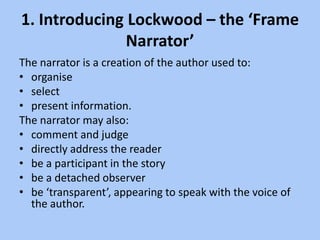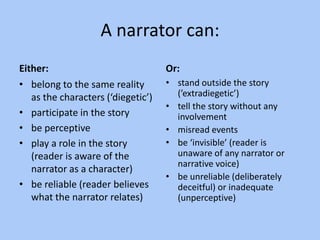Sets found in the same folder. Narratives are often identified as first second or third person based on the kinds of pronouns they utilize.
In first-person narration the narrator is a person in the story telling the story from their own point of view.

. Narrative Techniques and Structure. The narration usually utilizes the pronoun I or we if the narrator is speaking as part of a. Log in for more information.
Third person omniscient is a point of view where the narrator knows all the thoughts actions and feelings of all characters. In literature third-person point of view follows multiple characters and narrative arcs zooming in and out of a story the way a camera does in a movie. Because he has no respect for the material he teaches he makes no impression on his students.
However the narrator does not have to be a character in the text. Refer to Explorations in Literature for a complete version of the story. This narrator can be reliable or unreliable.
Text written in limited third person point of view affect a reader. Henrys use of third-person narration in After Twenty Years affect the story. Threw herself kicking and screaming.
The third-person point of view is a form of storytelling in which a narrator relates all the action of their work using third-person pronouns such as he she and they Its the most common perspective in works of fiction. Additionally we learn as she learns and we. In this story the narrator is Dana.
Without using I or we. It is a third-person perspective in which the narrator does not inhabit the thoughts of any character and only reports the events of the world according to what it objectively witnesses much in the way a movie camera records events an audience experiences a stage. A narrator only exists in fictional texts or in a narrative poem.
Search for an answer or ask Weegy. He did that they did something elseIn other words the voice of the telling appears to be akin to that of the author him- or herself. Any story told in the grammatical third person ie.
A narrator is the person from whose perspective a story is told. Instead of getting inside all the characters thoughts this limited omniscient observer only reveals what the widow is thinking. Memoir or Observer Narration - first person narrator is observer rather than main participant.
Omniscient in which the narrator knows all of the thoughts and. Asked 7222012 103806 PM. The advantage of a first person narration is that readers really get to know the thoughts and emotions of Dana.
They look through him when he speaks forget his name. When it is the latter it is important to notice how the adult voice affects the childs story. The effect for readers is a front-row seat to Louise Mallards surprising private reflections.
How does the word circular help explain the ending of the story in Larry. A story written from the perspective of a single person often feels more intimate because the reader has direct unfiltered access to the thoughts emotions and perceptions of a single character. Their indifference galls him more than he will admit.
The author may move from character to character to. When her parents refused to buy the toddler the candy she begged for the belligerent child threw herself kicking and screaming to the floor of the grocery store. Which evidence from the story shows the impact of the first-person narrator as described in Part A.
The detached third-person narrator is not all-knowing. Readers feel Bellas surprise when they learn that the love letters had been for Abuela. Third person narration is characterized by a point of view outside of the story.
The dramatic point of view is the only truly neutral perspective in literature. This is perhaps the most common sort of narration and was particularly popular with the nineteenth-century realist novel. Narrator can be confidante eyewitness or chorus provides offstage or background information.
There are two types of third-person point of view. The narrator narrates the text. Here are a few examples of the limited third-person view of from popular books.
In these situations writers may reach for a style of. Updated 12122016 33946 PM. The point of a narrator is to narrate a story ie to tell the story.
A third-person narrator can be all-knowing aware of every characters thoughts and feelings or limited focused on a single character or aware only what certain characters say and do. What Is Third-Person Point Of. It allows the reader to get to know each character.
First Person Point of View. But there are other kinds of stories that require a little more authorial involvement. To make the story more engaging and relatable for readers.
Read the passage A Modern Love Letter. A narrator may be a character in the text.

Third Person Omniscient Narrator Overview Examples Video Lesson Transcript Study Com

Examples Of Children S Books With A Sequence Structure And A Narrative Writing Style Nonfiction Text Structure Writing Instruction Narrative Writing

10 Things To Remember When Writing A Narrative Book Units Teacher


0 Comments